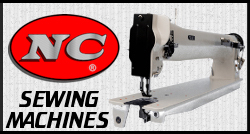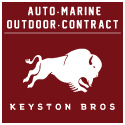-
Show off your latest custom upholstery work.I agree with Gareth, technology has come to replace many ways of doing things. CNC router machines can replicate foam molds to required and precise measures. I think it is more functional than 'molding injected process'. Great idea!
The same happens with ´perforated leather'. Big presses with a lot of minuscule punchers/dies are used to do the little holes. Laser cutting machines (used for graphic designers and printers) has come to replace this process and can make any perforated design on leather/vinyl at a cheap price and faster than those big presses. -
Material stuck underneath sewingmachineHello Thierry, The 'feed dog' and 'needle plate' you are currently using look in good condition.
Perhaps, the 'feed dog' is too low positioned, and it needs a little regulation upwards to drag thick material much better. Generally, two bolts at front regulate the 'feed dog lever'.
Page H, and J of Manual: https://www.manualslib.com/manual/483278/Brother-Ls2-B837.html?page=10#manual -
Custom bench seatsThe 'listing wires' would be inserted in the 'sleeves/bags' which go attached/sewn to the seams of vinyl/leather pieces.
These videos would give us an idea: https://www.youtube.com/watch?v=lEozir4Ngp0&t=55s
A basic seat cover (min. ten:06)https://www.youtube.com/watch?v=UR0Sx1DhZJA&t=2s
I hope it helps! -
Custom bench seatsHello Kris, I would use one of next three ways to keep the inserts flat on foam base:
1. Glueing the pieces down onto foam base.
2. Most common way by using, 'listing wires'.
3. By using 'velcro material'. -
CornersCody Lunning, Certainly! thats is precisely what I have tried to explain.
Curved/round pieces should remain flat over the machine table while sewing. They should be simply moved over the table to always facing the machine operator. On the contrary, the upper straight piece should be the one to be 'manipulated', rolled, folded, etc. Of course, we could sew the other way, but it would be a little more difficult.
Just a particular tip some other car trimmers also follow as a standard rule.
Thanks for these interactive questions and answers related to our craft. -
CornersIMHO I think we should not cut off the seam allowance excess. I agree of cutting the foam in the seams...only the foam to avoid a bulky edge.
The seams would then be folded over to top view to get an even junction all around. It would help to give shape.
The cutting of seams too close the blind sewing junction would cause distortion along the edge.
I also agree that a straight edge piece should be sewn to a rounded seam piece. Although there are some exceptions. -
Continuing EducationEducation is the right word few upholsterers do not accept. The learning process should never stop, despite of being in the business for such a long time. We should be always trying to update and find new techniques to improve our jobs in order to please our customers and our own satisfaction.
Just a particular opinion, thanks. -
Continuing EducationHello John, It is so great to have here in this automotive upholstery forum ! Nice to meet you, through this means! Although, I have already met you through your interesting you tube videos.
I still remember when you were on former channel along with another young mate. I used to watch and enjoy many of your upholstery videos at that time. If I well remember, it was the Young Guns channel...upholstery, designs and fabrication.
I would like to commend you for your educational upholstery courses online! A praiseworthy effort because I know it is not an easy task to bring about these courses in a way to make an interested person learn.
My best wishes and success to you and renovated Lucky Needle Channel! -
Average amount of hours it should be takingInteresting events to consider in a shop to schedule and price our time in order to give estimates.
I am just a part time car trimmer doing jobs off and on. Perhaps I would also give a partial opinion not adjusted to updated trimmers who are in the business everyday.
A skilled upholsterer should be able to upholster a set of car seats (front and rear) in one day. Provided the seats are in good condition and counting with a helper to remove, disassemble, clean the seats, etc. Besides, doing same pattern or something similar, and no modifications.
Going at a slow pace and solving some issues(broken springs, torn foam, etc.) two days at most.
Sometimes repairing takes more time than doing the covers. I think a good point to consider before giving an estimate because it involves two jobs.
Door panels, one day at most.
Carpet, half day
Headliner (bow type) one day. cardboard type(half day)
Steering-wheel (no modifications) from 5 to 8 hours.
Headrest (simple pattern) 2 hours.
I guess to do the complete interior of a car would take a week if working on 'standard patterns'.
If some repairing or modifications the time would be longer and could take more than a week. A month or more. -
Replacing steering wheel foam?I want to share some related information I have found on internet:
https://www.youtube.com/watch?v=g2ZLEpHnh3M&list=PLD96NaKmT79ac96a270KGYM85g_7NhjN8&index=2
https://www.alumilite.com/store/Search.aspx?SearchTerms=steering%20wheel%20casting -
Technique help sewing a half circleSummarizing what Jack, Naseem and Matthew said, the concave edge should be sewn to the convex piece edge. In other words the upper piece (concave edge) should be manipulated over the flat insert (convex edge). The relief cuts are very important to alleviate the sewing procedure at a slow pace.
-
suspended headliner tuck strip?Despite I used it in the seventies I never knew the correct name in English. I am also curious to update names of some upholstery materials.
After several comments, I have realized we are clearly talking about 'headliner retaining strips':https://www.ebay.com/itm/52-53-54-FORD-MERCURY-SET-ROOF-TOP-HEADLINER-RETAINER-RETAINING-TACK-STRIPS-TRIM-/131181235492?nma=true&si=HV5UHkAvCcJyziiBlo5Ecd6UnGw%253D&orig_cvip=true&nordt=true&rt=nc&_trksid=p2047675.l2557
In the worst case scenario, of not getting the original we would use the 'Ply grip flex trim':
https://www.ebay.com.au/itm/Professional-Flexible-Metal-Back-Tacking-Strip-Ply-Grip-1-5-Metre-Lengths-/141968515741 -
Wine stain on leatherI agree with Steve's advice. I have never used naphta. I do not know how strong reacts to not alter the coat of transparent sealer/lacquer automotive (top finished) leathers have.
It would be advisable to do some tests beforehand on inconspicuous areas.
I have found some tips on internet:https://www.wikihow.com/Remove-Red-Wine-Stains-from-Leather -
Alternatives to AlcantaraI want to share an ebay link as an option to get Alcantara material:
https://www.ebay.com/itm/ORIGINAL-Alcantara-Stoff-Pannel-SCHWARZ-150cm-Preis-fur-1-00mx1-50m-Kein-Imitat/183176744561?hash=item2aa62f4e71%3Ag%3AT6gAAOxyRNJSneX-&_sacat=0&_nkw=alcantara&_from=R40&rt=nc&_trksid=m570.l1313
I received an email from Gulf Fabrics, as follows:
Cesar,
We can no longer supply the Alcantara Automotive material. Hopefully, we will be able to begin ordering again in 2019. We only have limited stock available of a couple of colors.
Best regards,
Joe Martinez/Gulf Fabrics, Inc. -
Do you use a Serger in your shop?You are right, it looks like, and we all know how they finish. But perhaps, it is another kind of stronger bonded material.
-
Do you use a Serger in your shop?Yes, the glue sprayer seems to be soft and not too sticky just to hold the leather piece down and not let wrinkles pop up. I basically do not use this method, I just baste the leather with some points of glue all around the edges leaving it 'loose'.
-
Do you use a Serger in your shop?It looks the same but heavy duty for heavy fabrics such as denim, etc.
https://www.pegasus.co.jp/en/machine/detail/series/s103/EXT3216-A04_435K
https://www.youtube.com/watch?v=eaUlzYS1vsk (caterpillart presser foot)
I want to correct my former comment. It is min. 3:37 of the video, sorry. -
Continuing EducationHello Don, It seems you are seriously 100% getting involved in this beautiful upholstery trade.
Even though I do not contribute much to the forum, just off and on, I enjoy a lot reading interesting upholstery articles (Big thanks to Naseem and Nadeem brothers for the effort, 'cause I know it is not easy!) and posts of many expert trimmers who eagerly share with us helpful tips. As a saying says: we never stop learning! And also think the main idea is pick up more knowledge everyday from here and there.
I have watched some of master John Polock YouTube's videos and look pretty interesting to me. A passionate of the upholstery art too.
But fortunately in this forum I have realized we also have excellent automotive upholstery teachers full of expertise who have written books and recorded DVD's
http://www.thehogring.com/2018/05/16/these-5-trimmers-won-sid-chavers-dvds/
http://www.thehogring.com/2017/09/28/learn-auto-upholstery-with-this-new-book/ -
Do you use a Serger in your shop?The advantage of serger machine is flattens the edge of foamed piece making next sewing procedures easier. I have tought in buying one.
In this video a master trimmer of Leather Seats.com does a demonstration with this machine (minute 13:37)https://www.youtube.com/watch?v=C3tcrZNKRCc -
Replacing steering wheel foam?Perhaps you first would have to make a 'rigid mold' (metallic or wood frame) where the foam would be injected. I have heard there are some places where the 'polyurethane resins' to make foam in different densities are sold, and they also offer some kind of related advisement to their customers.
Hopefully some of these ideas would help to solve the issue:
https://www.youtube.com/watch?v=3wh5nr0IChA
https://www.youtube.com/watch?v=MnwgMmqY4RI -
Metal motorcycle seat panHello John, You could first use some 'yellow glue' to attach/fasten the cover to the metal pan. Then to have it more secure you could drill little holes to put in some little screws (7mm /5/16" long approx.)
More ideas on a Google link: https://www.google.com.mx/search?q=metal+pan+for+a+motorcycle+seat&tbm=isch&source=iu&ictx=1&fir=-XxOIS3WeAvjgM%253A%252CPBllvJ2rbH2pcM%252C_&usg=__spuyfk2_TduAFJuirdXduHsQplI%3D&sa=X&ved=0ahUKEwiR7bf74snYAhXMSyYKHTpqD9gQ9QEINDAA#imgrc=-XxOIS3WeAvjgM: -
Thoughts about double needle sewing machinesHello Sander, Definetely, I would also go for a double needle, post bed, industrial sewing machine. I still have not bought one like that, but I have to do it at any moment. As an upholsterer IMHO I consider to do the job easier and get a better and perfect professional job is important to do the double stitches/french seams by using one of these machines.
I was checking this attached video where the young master trimmer perfectly performs the double stitches on a post bed sewing machine (min 5:06 to min 5:40):
https://www.youtube.com/watch?v=C3tcrZNKRCc&t=2s -
Hiding staplesHopefully, you could find a similar (upholstery edge trim) on this link: https://www.amazon.co.uk/Edge-Trim-Black-per-metre/dp/B008FQ5BVY
-
Upholstering plasticI usually skive the seams in a sloped way. For the first closing sewing I use a thin needle 110/18 to avoid big holes and a 'thread clashing view'.
Master trimmer Brent Parker shows us a nice way of approaching 'french seams' on dahsboards and other pieces which do not suffer tension.
http://www.thehogring.com/2012/09/13/how-to-sew-a-seamless-french-seam/ -
Plastic weldsI agree with Chris, just cut all of the plastic heads off to remove the insert panel. Before putting it back to its position I drill all of the studs just enough to let in a small self-drilling wafer screw. If necessary a small washer would help to keep in place the screws. Some resin over the heads would give an original appearance.
Cesar Chavez

Start FollowingSend a Message








- Terms of Service
- Useful Hints and Tips
- Sign In
- Created with PlushForums
- © 2025 The Hog Ring